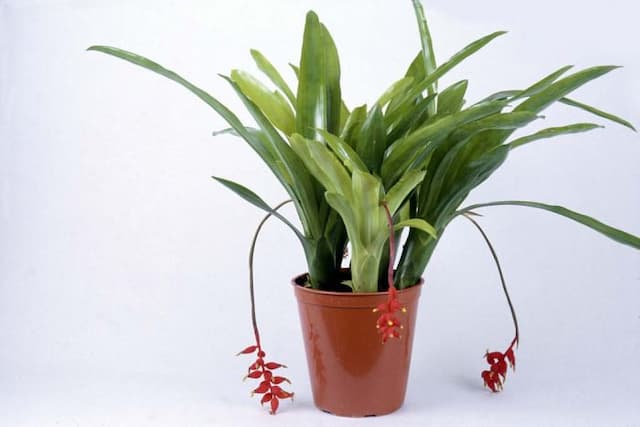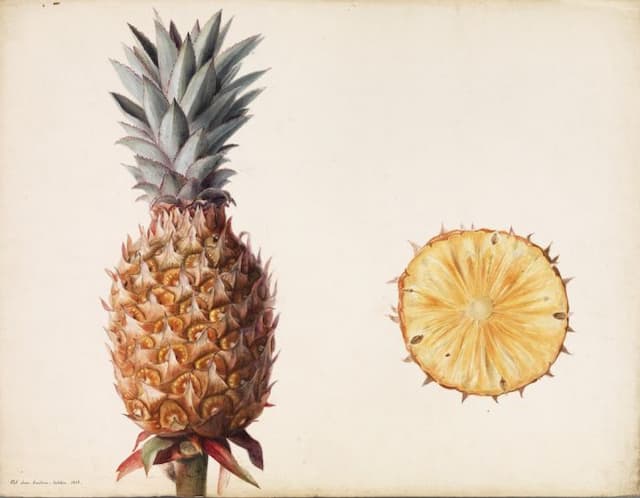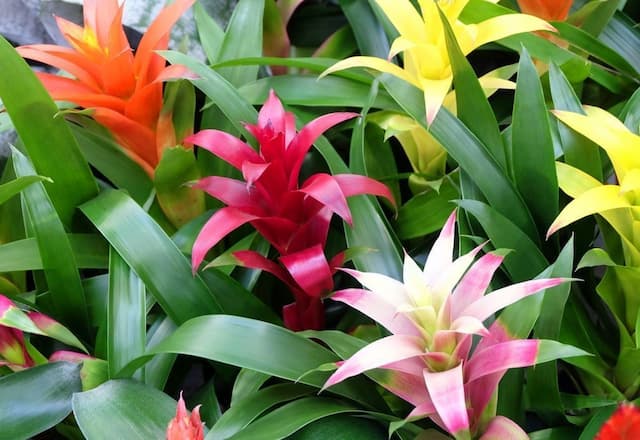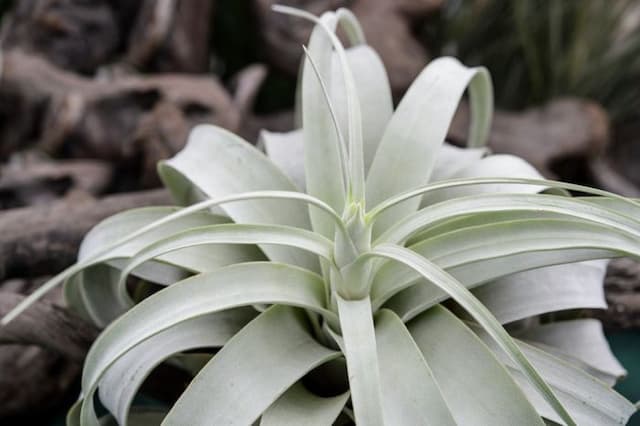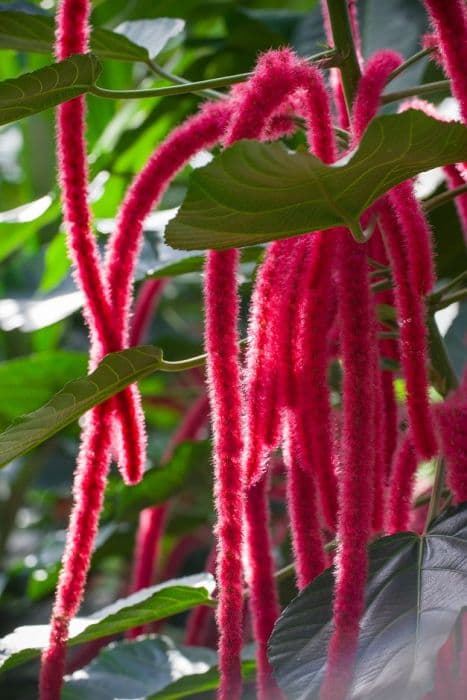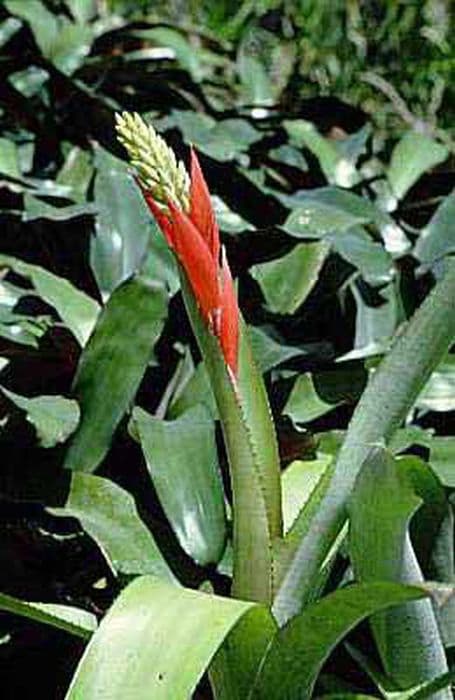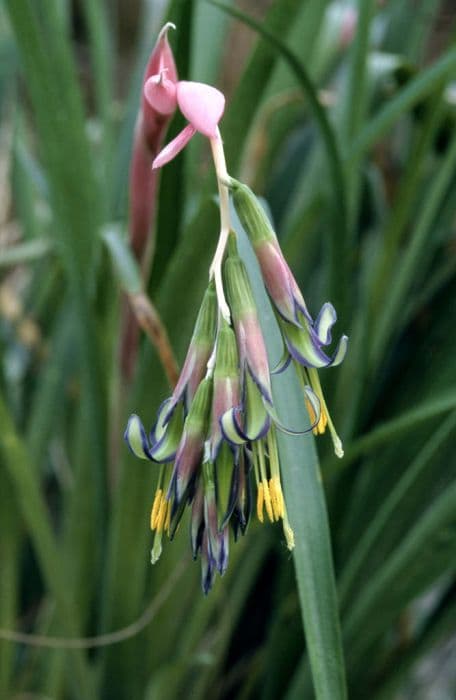Shirley Temple Air Plant Tillandsia streptophylla

ABOUT
The Tillandsia streptophylla, commonly known as the Shirley Temple air plant due to its curly leaves that are reminiscent of the actress's ringlets, is a unique and attractive plant. Its leaves are silvery-green and have a tendency to curl inwards, creating a somewhat bulbous and twisty appearance. The curls become more pronounced under drier conditions, giving the plant a whimsical look. When it's time to bloom, the Shirley Temple air plant produces a colorful flower spike, which can vary in hue, often showing shades of pink or red before the flower emerges. The bloom itself is typically a striking purple or violet, adding to the plant's decorative appeal. This air plant's leaves are covered with tiny scales that give them a fuzzy texture and an almost frosted look. Owing to these distinctive features, the Shirley Temple air plant makes for an intriguing display whether it's mounted on a piece of wood, resting within a terrarium, or presented in a hanging air planter.
About this plant
 Names
NamesFamily
Bromeliaceae
Synonyms
Shirley Temple Air Plant, Curly Air Plant, Xerographica’s Little Cousin
Common names
Tillandsia streptocarpa, Tillandsia circinnatoides, Tillandsia circinnata subsp. streptophylla, Tillandsia glabrior, Tillandsia streptophylla var. stricta, Tillandsia streptophylla var. glabrior, Tillandsia streptophylla var. kienastii
 Toxicity
ToxicityTo humans
Tillandsia streptophylla, commonly known as the Shirley Temple or Curl-Leaf Tillandsia, is generally considered non-toxic to humans. There is no significant evidence to suggest that handling or ingesting this air plant poses a risk of poisoning or causes harmful symptoms in humans.
To pets
The Shirley Temple or Curl-Leaf Tillandsia is not known to be toxic to pets. If a pet were to ingest part of the plant, it is unlikely to cause poisoning or exhibit any severe symptoms due to the plant's non-toxic nature. However, ingestion could potentially result in mild gastrointestinal upset simply from the ingestion of non-dietary material.
 Characteristics
CharacteristicsLife cycle
Perennials
Foliage type
Evergreen
Color of leaves
Silver-green
Flower color
Pink
Height
0.5-1 feet [15-30 cm]
Spread
0.5-1 feet [15-30 cm]
Plant type
Bromeliad
Hardiness zones
10
Native area
Central America
Benefits
 General Benefits
General Benefits- Low Maintenance: Tillandsia streptophylla, commonly known as Shirley Temple or Air Plant, requires minimal watering and no soil, making it easy to care for.
- Décor Flexibility: Its unique appearance and ability to grow without soil allows for creative display options in various types of home decor.
- Pet-Friendly: Shirley Temple is non-toxic, making it safe to have around pets.
- Adaptability: It thrives in a range of lighting conditions, from bright indirect light to more shaded areas.
- Propagation Ease: This air plant can be easily propagated from offsets, providing the opportunity to expand your collection or share with others.
 Medical Properties
Medical PropertiesThis plant is not used for medical purposes.
 Air-purifying Qualities
Air-purifying QualitiesThis plant is not specifically known for air purifying qualities.
 Other Uses
Other Uses- Artistic Decor: Tillandsia streptophylla, commonly known as Shirley Temple, can be used by artists and interior designers to create unique, textured elements in art installations or home decor.
- Jewelry Pieces: The intricate structure of Shirley Temple can be dried and incorporated into statement jewelry, such as necklaces and earrings, for a natural look.
- Education and Research: This plant serves as an educational tool to study epiphytic plant biology, adaptions to xeric environments, and mutualistic relationships with pollinators.
- Wedding Bouquets: Adding a touch of green, Shirley Temple can be included in bridal bouquets for a lasting, maintenance-free floral element.
- Fashion Accessories: The plant's unique appearance can inspire and be included in the design of eco-friendly fashion accessories, such as brooches or hat decorations.
- Photographic Subjects: Due to their visual appeal, these plants are often used by photographers looking to add an exotic or unusual element to their compositions.
- Biophilic Design: Integrating Shirley Temple into living spaces or office environments as a part of biophilic design can enhance the connection to nature and improve well-being.
- Seasonal Decorations: They are versatile for use in seasonal decor, such as creating everlasting wreaths or ornaments for Christmas that don't require watering.
- Craft Projects: With the right care, Shirley Temple can be used in various craft projects, where their resilience allows them to be manipulated without damage.
- Collector's Item: Plant enthusiasts often collect different species of Tillandsia, including Shirley Temple, due to their unique characteristics and ease of care.
Interesting Facts
 Feng Shui
Feng ShuiThe Shirley Temple is not used in Feng Shui practice.
 Zodiac Sign Compitability
Zodiac Sign CompitabilityThe Shirley Temple is not used in astrology practice.
 Plant Symbolism
Plant Symbolism- Resilience: Tillandsia streptophylla, commonly known as "Shirley Temple" or "Curl-Leaf Air Plant," typically grows in challenging environments on other trees or rocks without soil, demonstrating adaptability and toughness. Its ability to thrive in harsh conditions symbolizes resilience and perseverance in life's difficult times.
- Independence: As an epiphyte, the Shirley Temple Air Plant doesn't rely on soil to grow, drawing water and nutrients from the air through its leaves. This characteristic promotes a symbolism of self-sufficiency and the ability to prosper in less-than-ideal circumstances.
- Freedom: The plant’s growth habit, not being tied to the earth, can represent freedom and a free-spirited nature, unconstrained by traditional boundaries.
- Air purity: Like other air plants, Tillandsia streptophylla is also symbolic of air purity and clean environments as it depends on clean air for its survival, taking in carbon dioxide and releasing oxygen.
- Uniqueness: The plant's distinctive appearance, with its curled, twisting leaves that can resemble ringlets, stands out among other species, symbolizing uniqueness, individuality, and the beauty of being different.
- Flexibility: The soft, curling leaves of the Shirley Temple Air Plant can indicate flexibility and the ability to adapt to changing circumstances, just as the leaves respond to varying levels of humidity.
 Water
WaterThe Tillandsia streptophylla, commonly known as the Shirley Temple Air Plant, should be watered by soaking in water for 20-30 minutes weekly. During the soaking, ensure that the plant is fully submerged. In drier conditions or during hot summer months, soaking twice a week may be necessary. Always shake off any excess water after soaking to prevent rot, especially inside the rosette of leaves. Over the course of a month, you may need to use approximately 1-2 gallons of water, depending on the size and number of plants being maintained.
 Light
LightThe Shirley Temple Air Plant prefers bright, indirect light. It should be placed near a window that receives ample sunlight but should be protected from direct sunlight during the peak hours of the day to avoid scorched leaves. An east or west-facing window often provides the ideal lighting conditions, where the plant can benefit from the morning or late afternoon sun.
 Temperature
TemperatureThe Shirley Temple Air Plant thrives in temperatures between 50 and 90 degrees Fahrenheit. It can survive minimum temperatures of around 50 degrees but should not be exposed to temperatures below 45 degrees, as it may cause damage to the plant. Ideally, maintaining a warm environment close to 70 degrees Fahrenheit is best for optimal growth.
 Pruning
PruningPruning of the Shirley Temple Air Plant is typically done to remove any dead or brown leaves to maintain the plant's appearance and health. Prune as needed, usually every few months, using sharp scissors to prevent tearing the leaves. The best time for pruning is during or just after the growing season when the plant recovers more quickly.
 Cleaning
CleaningAs needed
 Soil
SoilTillandsia streptophylla, commonly known as the Shirley Temple air plant, does not require soil as it absorbs water and nutrients through its leaves. The best mix for this epiphytic plant is not a soil-based one but rather an attachment to a substrate such as a piece of driftwood, bark, or a specialized air plant holder. The pH is not relevant as it does not grow in soil.
 Repotting
RepottingThe Shirley Temple air plant does not require traditional repotting since it is not soil-dependent. Instead, it may need remounting or transferring to a new support if its current mount deteriorates or if the plant outgrows it, which is infrequent and based on condition rather than a time schedule.
 Humidity & Misting
Humidity & MistingThe Shirley Temple air plant thrives best in humidity levels of 50-70%, which mimics its native tropical environments. It is tolerant of less humid conditions but may require more frequent misting to maintain proper hydration in dryer atmospheres.
 Suitable locations
Suitable locationsIndoor
Mount on wood or place in a bright spot; mist weekly.
Outdoor
Attach to sheltered trees; keep away from frost.
Hardiness zone
10-11 USDA
 Life cycle
Life cycleTillandsia streptophylla, commonly known as the Shirley Temple Air Plant, begins its life cycle as a tiny seed dispersed by wind. The seed eventually lands in a suitable location, often on a tree branch, where it germinates and develops into a seedling, anchoring itself with roots that serve only for attachment, not nutrient uptake. As it matures, it absorbs water and nutrients from the air through specialized leaf structures called trichomes. The plant reaches maturity and produces a colorful inflorescence, which attracts pollinators such as hummingbirds or insects for sexual reproduction. After pollination, the plant sets seed while the base of the parent plant begins to produce offsets, or "pups," a form of asexual reproduction. The life cycle is completed when the original plant eventually dies, leaving the pups to continue the growth cycle.
 Propogation
PropogationPropogation time
Spring to Summer
Propogation: Tillandsia streptophylla, commonly known as Shirley Temple or Curl-Leaf Tillandsia, is most successfully propagated through the division method. This method involves separating the offsets, which are also known as "pups," that grow at the base of the parent plant. The best time to propagate Shirley Temple is during the spring or early summer when the plant's growth is most vigorous. To propagate, gently remove the pups when they are about one-third the size of the mother plant, ensuring that they have a few roots attached if possible. The offsets can then be placed onto a supporting structure or medium where they can attach themselves and be kept in bright, indirect light with proper air circulation. With appropriate water and care, these pups will gradually grow into independent plants. This method of propagation is popular due to its simplicity and effectiveness, allowing enthusiasts to easily expand their collection of Tillandsia streptophylla.
